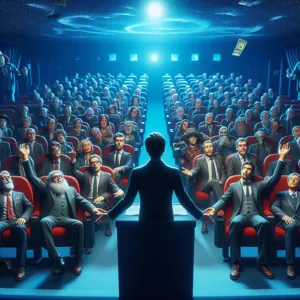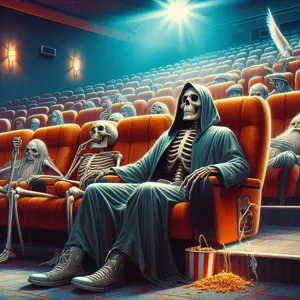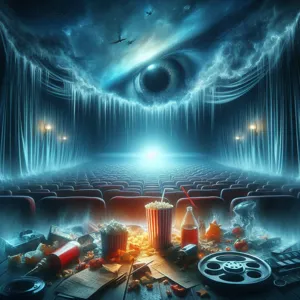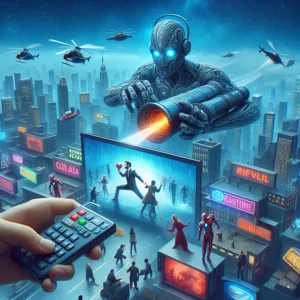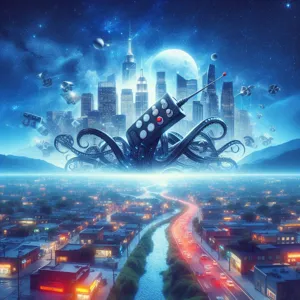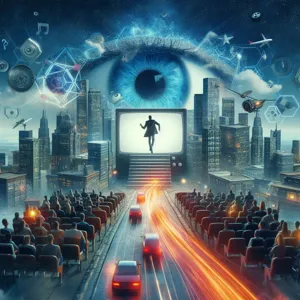In the ever-evolving landscape of cinema, the power of a well-crafted movie review is undeniable.
With the vast array of films vying for audience attention each week, the voices of critics and viewers alike have the potential to make or break a box office hit. From glowing accolades that send audiences rushing to theaters to scathing critiques that tarnish a film’s reputation before it even hits the screen, reviews play a pivotal role in shaping audience choices. As we delve into the intricate relationship between movie reviews and box office success, we’ll explore how these assessments influence viewer expectations, drive marketing strategies, and ultimately determine which films become cultural phenomena. Join us on this cinematic journey as we uncover the profound impact of reviews on the art of storytelling and the business of filmmaking.
1. Introduction: The Impact of Movie Reviews on the Box Office

In the ever-evolving landscape of cinema, the influence of movie reviews has become a formidable force that shapes audience choices and, ultimately, box office success. As moviegoers are bombarded with an overwhelming array of films vying for their attention, the opinions of critics and fellow viewers serve as crucial navigational tools in their decision-making process. A well-crafted review can elevate a film from obscurity to must-see status, while a scathing critique can swiftly diminish its chances of drawing crowds to theaters.
The digital age has amplified this phenomenon, with social media and online platforms providing instant access to reviews and ratings. Audiences no longer rely solely on traditional print critics; they consult a multitude of voices, from professional reviewers to amateur bloggers and social media influencers. This democratization of film criticism means that a single review can ignite a viral conversation, generating buzz that propels a film into the spotlight or buries it under the weight of poor reception.
Moreover, the emotional resonance of a review can sway audience sentiment in profound ways. A glowing endorsement can evoke excitement and anticipation, while a lackluster assessment may instill doubt, steering potential viewers away. As such, filmmakers and studios are acutely aware of the power of reviews—not just as a reflection of quality, but as a catalyst for box office performance. In this blog post, we will explore the intricate relationship between movie reviews and audience choices, delving into how they shape perceptions, influence attendance, and ultimately determine a film’s fate at the box office. Join us as we uncover the mechanics of this dynamic interplay and its implications for filmmakers, critics, and movie lovers alike.
2. The Evolution of Movie Reviews: From Print to Digital
The evolution of movie reviews from print to digital has transformed the landscape of film criticism and audience engagement in remarkable ways. In the early days of cinema, reviews were confined to the pages of newspapers and magazines, where film critics wielded significant influence over public perception. These seasoned writers, often regarded as gatekeepers of taste, shaped the viewing habits of audiences with their carefully crafted opinions, which were usually published days or weeks after a film’s release. For many, the Sunday paper became a ritual, with readers eagerly flipping through the pages to discover which films were deemed worthy of their time and money.
As technology progressed, the rise of the internet marked a seismic shift in how movie reviews were disseminated. The advent of online platforms enabled immediate access to film critiques, allowing audiences to read reviews the moment a film premiered—or even before. Websites like Rotten Tomatoes and Metacritic became authoritative sources for aggregate scores, giving potential viewers a snapshot of critical consensus at a glance. This democratization of film criticism meant that not only professional critics but also everyday moviegoers could share their thoughts, creating a vast array of voices that shaped audience expectations and choices.
Social media further revolutionized the space, allowing reviews to spread virally across platforms like Twitter, Instagram, and TikTok. Audiences now engage with films in real time, sharing their opinions through hashtags and short video clips, often influencing their peers in ways traditional reviews could not. The “instant review” phenomenon, where viewers express their thoughts immediately after watching a film, has created a new layer of urgency around movie-going, making the conversation around a film as dynamic as the film itself.
In this digital age, the power of movie reviews has not diminished; it has evolved. Filmmakers and studios now pay closer attention to the buzz generated online, recognizing that a single viral tweet or TikTok review can propel a film from obscurity to box office gold. As audiences increasingly turn to their screens for recommendations, the landscape of movie reviews continues to adapt, reflecting the ever-changing tastes and preferences of viewers in a fast-paced digital world.
3. How Critics Influence Audience Perception

Critics wield significant influence over audience perception, acting as the gatekeepers of cinematic quality in an industry flooded with options. Their reviews can elevate a film from obscurity to box office gold or plunge it into the depths of disappointment, often within mere hours of release. When a critic shares their insights, they do more than just evaluate a film’s merit; they shape the conversation surrounding it.
Consider the impact of a well-timed review from a reputable source. A glowing recommendation from a respected critic can spark interest and curiosity, igniting a desire among potential viewers to experience the film for themselves. On the flip side, a scathing critique can deter audiences, even those who might have been on the fence. This dichotomy is particularly evident in the age of social media, where reviews can spread like wildfire, influencing public sentiment and shaping group discussions.
Moreover, critics often delve into the nuances of storytelling, performance, direction, and cinematography, offering insights that resonate with audiences on a deeper level. They provide context and analysis that can enhance viewers’ appreciation of a film, making them more likely to engage with the material and recommend it to others. As films are released, their scores and ratings on platforms like Rotten Tomatoes or Metacritic become benchmarks for success, with high ratings often translating to larger audiences.
Ultimately, the relationship between critics and audiences is symbiotic. Critics strive to provide honest, informed opinions that guide viewers, while audiences lean on these insights to navigate their choices in an ever-expanding landscape of cinematic offerings. In this way, critics not only influence immediate box office performance but also contribute to the lasting legacy of a film, shaping its place in cultural discourse long after the credits roll.
4. The Role of Online Review Aggregators (Rotten Tomatoes, Metacritic)
In today’s digital age, the power of online review aggregators like Rotten Tomatoes and Metacritic cannot be overstated. These platforms serve as the modern-day oracle for moviegoers, influencing their decisions long before they set foot in a theater. With a vast repository of audience and critic reviews, these sites provide a consolidated rating that encapsulates the overall sentiment surrounding a film.
Rotten Tomatoes, for instance, employs a unique “Tomatometer” system, which aggregates critics’ reviews to deliver a percentage score that indicates the film’s critical reception. A fresh rating can create a surge of interest, while a “rotten” score might lead potential viewers to reconsider their plans. The “Audience Score” further complements this by reflecting the general public’s reaction, giving a well-rounded view of a film’s appeal.
Metacritic, on the other hand, takes a slightly different approach by assigning a weighted score based on reviews from a diverse range of critics, offering a nuanced perspective on how a film has been received. This site also showcases user reviews, allowing fans to voice their opinions and engage in discussions, which can be pivotal in swaying undecided moviegoers.
The influence of these aggregators is particularly potent in a world where choices are abundant and attention spans are short. A glowing review or high score can propel a lesser-known indie film into the spotlight, while a poor reception can doom even the most highly anticipated blockbusters. Filmmakers and studios are acutely aware of this dynamic, often launching targeted marketing campaigns around these scores to capitalize on the visibility and credibility they provide.
Moreover, the immediacy of these platforms allows for real-time feedback, meaning that a film’s success can pivot dramatically in the first few days post-release, depending on audience and critic reactions. In essence, online review aggregators have become gatekeepers in the cinematic landscape, shaping not only the audience’s choices but also the fate of films at the box office. As the adage goes, “perception is reality,” and in the realm of cinema, these platforms are key players in crafting that perception.
5. The Psychology Behind Review Scores and Ratings
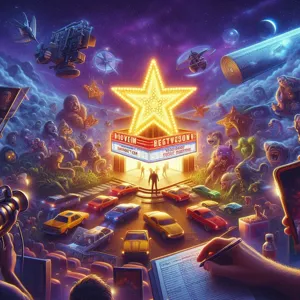
When it comes to the world of cinema, the numbers tell a compelling story—one that reflects our collective preferences and influences our individual viewing choices. The psychology behind review scores and ratings is a fascinating blend of human behavior, social influence, and cognitive bias that shapes how audiences engage with films.
Firstly, consider the sheer impact of a star rating or a critic’s score. Research suggests that people tend to place a significant amount of weight on what others think, especially when making decisions in uncertain environments. A high rating can create an immediate sense of trust and validation, making potential viewers feel more secure in their choice to invest time and money into a film. Conversely, a low score can act as a deterrent, often leading audiences to dismiss a movie before they even consider its plot or cast.
The phenomenon of “bandwagon effect” plays a crucial role here as well. When a film receives a flurry of positive reviews, it can ignite a sense of urgency and excitement among audiences. People want to be part of the conversation, to experience what others are raving about, which can lead to increased ticket sales and box office success. This is why studios often strategically time their promotional campaigns to coincide with favorable reviews or awards buzz; they understand the powerful ripple effect that positive feedback can create.
Moreover, the way ratings are presented can also influence perception. A film that boasts a 90% score on Rotten Tomatoes may seem far more appealing than one rated at 75%, even if the difference in quality is marginal. This perception is heightened by the “halo effect,” where positive traits in one area (like a stellar review) can overshadow negatives (like a lackluster trailer or an unknown cast).
Finally, it’s important to acknowledge the role of social media as a platform for sharing reviews. Instantaneous feedback from audiences can amplify opinions, creating a feedback loop where every tweet or post can sway the opinions of hundreds, if not thousands. The digital age allows viewers to contribute to the conversation, influencing their peers and creating a community-driven assessment of films.
In conclusion, the interplay between review scores and audience choices is not just about numbers; it’s an intricate dance of psychology, social dynamics, and personal preferences that ultimately determines a film’s success or failure at the box office. Understanding this psychology allows filmmakers, marketers, and critics alike to navigate the complex landscape of audience engagement in a way that resonates deeply with viewers.
6. Case Studies: Films That Rose or Fell Based on Reviews
In the ever-evolving landscape of cinema, the impact of reviews can make or break a film’s success at the box office. Case studies of specific films showcase how critical reception has shaped audience choices, leading to either meteoric rises or disheartening falls.
Take, for instance, the case of **”The Shawshank Redemption.”** Initially released in 1994, the film struggled at the box office despite its stellar performances and a poignant narrative. However, the tide began to turn as movie critics showered it with praise, and audiences gradually discovered its profound storytelling. Over time, “The Shawshank Redemption” climbed to the top of the IMDb ratings, ultimately becoming a beloved classic, demonstrating how positive reviews can breathe new life into a film long after its theatrical run.
On the flip side, consider **”Batman v Superman: Dawn of Justice.”** Despite high expectations and a built-in fanbase, the film was met with a barrage of negative reviews upon its release in 2016. Critics lambasted its muddled plot and uneven pacing, which significantly impacted audience perception. Many potential viewers opted to skip the film in theaters, opting instead to wait for home viewing—if they engaged with it at all. The disappointing box office numbers and mixed audience reactions highlighted how negative critiques can undermine even the most anticipated blockbuster.
These case studies illustrate the powerful role that reviews play in shaping public perception and influencing box office performance. As audiences increasingly rely on critics and peer reviews before making viewing choices, filmmakers are increasingly aware that the critical reception can dictate their film’s fate, both immediately and in the long run. Whether it’s through the cultivation of a strong critical consensus or navigating the pitfalls of negative feedback, the relationship between film reviews and audience choices remains a crucial aspect of cinematic success.
7. The Power of Social Media and Influencers in Shaping Opinions

In today’s digital landscape, social media and influencers wield immense power in shaping public opinion, particularly in the world of cinema. Gone are the days when traditional reviews from newspapers and film critics held the monopoly on audience insight. Now, platforms like Twitter, Instagram, TikTok, and YouTube have become the new arenas where movie perceptions are formed and shared.
Social media allows for real-time reactions and interactions, creating a dynamic environment where buzz can build or crumble in a matter of hours. A single tweet or Instagram post featuring a captivating scene from an upcoming film can ignite anticipation, turning a relatively unknown title into a must-see blockbuster. On the flip side, a negative review from a popular influencer can dissuade potential viewers, even if the film has received accolades from professional critics.
Influencers, with their dedicated followings, serve as both tastemakers and opinion leaders. Their recommendations carry weight, especially among younger audiences who prioritize authenticity and relatability over traditional advertising. For filmmakers and studios, partnering with the right influencers can translate into a powerful promotional strategy. When influencers share their thoughts on a film, whether through a detailed review or a casual mention in their daily content, they can spark conversations, create trends, and even influence box office performance.
Moreover, the interactive nature of social media allows audiences to engage directly with content creators and other viewers. This creates a sense of community and shared experience, prompting discussions, debates, and ultimately shaping collective opinions about a film. Hashtags, challenges, and viral trends can amplify a movie’s visibility, leading to increased ticket sales and a broader reach.
In an age where social media shapes narratives, understanding its influence is crucial for filmmakers and marketers alike. The power of social media and influencers to shape opinions is undeniable, and their role in the film industry continues to grow, proving that in the world of cinema, perception is often just as important as the content itself.
8. Audience Reviews vs. Professional Critic Reviews: The Clash
In the ever-evolving landscape of cinema, the debate between audience reviews and professional critic reviews is both fascinating and complex. On one side, we have the seasoned critics—those who have devoted years, if not decades, to studying film theory, direction, cinematography, and performance. Their reviews often provide a nuanced, in-depth analysis of a film’s artistic merit, technical execution, and cultural significance. They dissect plot holes, dissect character arcs, and evaluate a film’s alignment with cinematic traditions, all of which can offer audiences a deeper understanding of the work.
On the other side, we have the voice of the masses—the everyday moviegoers who bring their personal experiences, expectations, and emotional responses into their reviews. Audience reviews are spontaneous, often fueled by the visceral impact a film has on viewers. They are raw, unfiltered, and reflect the collective sentiment of those who flock to theaters, sometimes resulting in a stark contrast to the polished critiques of professionals.
This clash becomes especially pronounced in the age of social media and online platforms, where audience ratings can skyrocket or plummet in a matter of hours. A film that receives critical acclaim might find itself underwhelmed by public reception, while a seemingly mediocre film can achieve cult status based on enthusiastic audience reviews. The viral nature of social media can amplify this disparity, as tweets, TikToks, and Instagram posts quickly spread opinions that can sway the general public’s perception and attendance.
Moreover, the growing influence of platforms like Rotten Tomatoes and IMDb has democratized the review process, allowing audiences to have a significant say in a film’s overall rating. This has led to a more complex dialogue between critics and viewers. For film studios and marketers, understanding this dynamic is crucial. They must navigate the waters between appealing to critics while also engaging with the passionate opinions of their audience. Ultimately, in this clash of perspectives, both reviews play a pivotal role in shaping box office success, influencing not just ticket sales, but also the way films are discussed and remembered in the cultural zeitgeist.
9. The Importance of Timing: When Reviews Are Released
Timing plays a pivotal role in the impact of movie reviews on audience choices and a film’s box office success. The release date of a review can be as influential as the content itself. If a review drops at a strategically advantageous moment, it can create a ripple effect that boosts ticket sales, while poorly timed reviews may fail to resonate with potential viewers.
Consider the buildup to a film’s premiere—often, reviews are strategically released just days before opening weekend. This timing is designed to generate buzz and excitement. When critics publish glowing reviews before the film is available to the public, they create a sense of urgency and anticipation. Audiences are more likely to flock to theaters, eager to see what the buzz is all about. A well-timed positive review can turn a film into a must-see event, propelling it to box office success almost overnight.
Conversely, releasing a review too early can lead to a different outcome. If critics weigh in months in advance, their opinions may fade from memory by the time the film is released. This is especially critical for franchise films or sequels, where audience expectations and excitement can diminish if they are left hanging for too long. In some cases, a negative review released too close to opening weekend can deter potential viewers, leading to disappointing box office returns and a film’s quick descent into obscurity.
Additionally, timing isn’t just about when reviews are released; it’s also about the context in which they appear. For instance, if a film competes with high-profile releases or is overshadowed by major events (like award shows or popular cultural phenomena), even the most favorable reviews may struggle to make an impact. Understanding the broader landscape of film releases and leveraging review timing to navigate this landscape is crucial for filmmakers and studios aiming for box office gold.
In summary, the importance of timing in the release of movie reviews cannot be overstated. Whether it’s creating anticipation or mitigating potential backlash, thoughtful timing can significantly influence audience choices and ultimately determine a film’s success or failure at the box office.
10. The Role of Pre-release Screenings and Buzz
Pre-release screenings play a pivotal role in shaping audience expectations and driving buzz around upcoming films. These exclusive events allow a select group of critics, influencers, and industry insiders to experience a movie before its official release, enabling them to craft their reviews and opinions while the excitement is still fresh. The reactions from these early viewers can significantly influence the general public’s perception, often setting the tone for the film’s anticipated reception.
When a movie receives glowing reviews from pre-release screenings, it can create a cascade of positive buzz that spreads like wildfire across social media platforms and entertainment news outlets. This early excitement can generate a sense of urgency among potential viewers, prompting them to secure tickets before the film even hits theaters. Conversely, if the feedback is lukewarm or negative, the film may struggle to gain traction, as audiences may be more hesitant to invest their time and money.
Moreover, the power of influencer marketing cannot be underestimated in this context. When popular figures in the entertainment industry or social media influencers share their thoughts about a film, their followers are likely to take notice. A few enthusiastic endorsements can spark a wave of interest, encouraging fans to flock to theaters in anticipation of a cinematic experience that has already been validated by trusted voices.
In an age where audiences are inundated with choices, pre-release screenings and the subsequent buzz they generate are essential in cutting through the noise. They not only shape audience choices but also play a crucial role in determining a film’s box office success, highlighting just how interconnected the world of cinema and consumer perception truly is. As filmmakers and studios continue to navigate this dynamic landscape, understanding the impact of early screenings will remain a key strategy in crafting successful releases.
11. How Marketing Strategies Leverage Reviews for Box Office Success
In the competitive landscape of film releases, marketing strategies have evolved to harness the power of reviews as a critical tool for box office success. Film studios and marketers understand that audience perception can make or break a movie’s financial performance, and reviews serve as a key influence in shaping that perception.
One of the most effective tactics is the strategic timing of review releases. Ahead of a film’s premiere, studios often arrange for early screenings for critics and influencers, encouraging them to share their insights on social media and popular review platforms. This pre-release buzz can create a snowball effect, generating excitement and anticipation among potential viewers. A handful of well-placed positive reviews can elevate a film’s profile, enticing audiences who may have been undecided to purchase tickets.
Moreover, marketing campaigns increasingly feature snippets of glowing reviews in trailers, posters, and social media ads. Phrases like “Critics are raving!” or “A must-see masterpiece!” serve to validate a film’s quality in the eyes of the audience, effectively leveraging social proof. This practice not only builds credibility but also taps into the psychological tendency of consumers to rely on the opinions of others, especially when considering how to spend their entertainment budget.
Another innovative approach is engaging with audiences through interactive platforms. Some studios encourage viewers to leave their own reviews shortly after screenings, fostering a sense of community and involvement. This not only helps create a dialogue around the film but also allows marketers to showcase positive audience feedback in real-time, further driving interest and ticket sales.
Furthermore, the rise of Rotten Tomatoes and Metacritic has made aggregate scores a focal point of marketing strategies. A high score on these platforms can be prominently displayed in promotional materials, signaling to potential viewers that the film has been well-received by both critics and audiences alike. Conversely, films with lower scores may struggle to attract viewers, underscoring the importance of fostering a positive reception early on.
In essence, the symbiotic relationship between marketing strategies and film reviews highlights how crucial audience perception is in the quest for box office gold. By skillfully leveraging reviews, marketers can not only enhance a film’s visibility but also create an irresistible allure that keeps audiences flocking to theaters, ensuring that the box office remains a thriving space for cinematic success.
12. The Consequences of Negative Reviews: A Deeper Look
Negative reviews can cast a long shadow over a film’s box office performance, often leaving lasting consequences that extend far beyond the opening weekend. When critics and audiences alike voice their discontent, the impact can ripple through various aspects of a movie’s trajectory. A single scathing review can deter potential viewers, as many moviegoers now rely heavily on the opinions of trusted critics before deciding to spend their hard-earned money at the cinema.
Consider the power of social media in today’s digital age, where a negative review can be shared and amplified within seconds. A tweet from a prominent film critic or a viral reaction video can reach millions, creating an echo chamber of negativity that influences more than just the film’s immediate viewership. This phenomenon is especially pronounced for high-profile releases with substantial budgets, where box office expectations are elevated. A film that opens to lukewarm or outright negative reviews often struggles to recover; word-of-mouth is a powerful beast, and once the narrative shifts to one of disappointment, it becomes increasingly difficult to reverse course.
Moreover, the consequences of negative reviews can also affect a film’s longevity in theaters. Many films rely on the momentum of positive word-of-mouth to sustain their box office runs, but negative reviews can cut that lifeline, leading to steeper drops in ticket sales as the weeks progress. For smaller, independent films, this can mean the difference between success and obscurity.
In addition, the impact of negative reviews can extend into future projects for filmmakers, actors, and studios. A poorly received film can tarnish reputations and influence casting decisions or funding opportunities for subsequent projects. In an industry where credibility and public perception are paramount, the shadow of a negative reception can linger, shaping the trajectories of careers for years to come.
Ultimately, negative reviews serve as a stark reminder of the critical role that audience perception plays in the film industry. They underscore the importance of quality storytelling, engaging performances, and thoughtful direction—elements that not only attract viewers but also foster a positive buzz that can propel a film to box office gold. In a world where every opinion counts, the stakes have never been higher for filmmakers aiming to capture the hearts of their audience.
13. The Impact of Star Ratings on Box Office Performance
When it comes to the world of cinema, star ratings hold immense power. These numerical scores, often ranging from one to five stars, serve as a quick reference for potential viewers, shaping their perceptions long before they step into a theater. The impact of star ratings on box office performance is profound; a film that garners a higher rating can experience a significant boost in ticket sales, while a lower rating could spell disaster for its financial success.
Think of it this way: in a marketplace flooded with options, a film’s star rating acts as both a beacon and a filter. Audiences often rely on these ratings as a shorthand for quality, using them to sift through the myriad of choices available to them. For example, a movie boasting a solid four or five-star rating is likely to spark curiosity and draw in crowds, as viewers trust that they will be investing their time and money in something worthwhile. Conversely, a film that earns a mere two stars might be dismissed outright, left to languish in obscurity.
This phenomenon is not merely anecdotal; studies have shown a direct correlation between star ratings and box office performance. Films that achieve high ratings often benefit from increased media coverage and word-of-mouth promotion, creating a positive feedback loop that further bolsters ticket sales. On the flip side, negative reviews can lead to a rapid decline in interest, as audiences flock to alternative titles that come with more favorable evaluations.
Moreover, the rise of social media and online platforms has amplified the effects of star ratings. With countless users sharing their reviews and opinions on sites like Rotten Tomatoes and IMDb, a film’s star rating can shift dramatically within days of its release. This instantaneous feedback can have immediate consequences for box office performance, as potential viewers are swayed by the latest buzz surrounding a film.
Ultimately, star ratings serve as a crucial barometer for audience expectations and preferences. For filmmakers and studios, understanding the weight that these ratings carry can be the difference between box office gold and a cinematic flop. As such, they must not only focus on creating compelling content but also anticipate how critics and audiences will respond to their work in order to maximize their film’s potential at the box office.
14. Conclusion: The Future of Movie Reviews in a Changing Landscape
As we draw our exploration of the intricate relationship between movie reviews and audience choices to a close, it’s essential to consider the future of this influential medium in an ever-evolving landscape. The rise of digital platforms and social media has revolutionized how we consume film criticism, making it more accessible than ever before. Traditional print reviews, once the gatekeepers of cinematic success, now share the stage with an array of voices—from amateur critics on YouTube to social media influencers with dedicated followings.
This democratization of film criticism has both its advantages and challenges. On one hand, diverse perspectives enrich the conversation around films, allowing audiences to discover gems that may have flown under the radar of mainstream reviewers. On the other hand, the sheer volume of opinions can lead to confusion, as audiences navigate a sea of conflicting viewpoints. The question of credibility looms large: how do viewers discern which reviews are worth their time and attention?
Moreover, as algorithms increasingly shape our online experiences, the role of personalization in movie recommendations cannot be overlooked. Viewers are more likely to be exposed to films that align with their viewing habits and preferences, potentially sidelining critically acclaimed works that don’t fit neatly into these personalized categories. This shift calls for a new kind of critic—one who can bridge the gap between traditional analysis and the fast-paced, opinion-driven culture of social media.
Looking ahead, the future of movie reviews will likely hinge on a blend of authenticity and authority. Audiences will continue to seek out genuine voices that resonate with their tastes, while also valuing the insights of seasoned critics who can provide depth and context. As the film industry adapts to these changes, so too must reviewers, embracing innovative formats and platforms that engage viewers in meaningful ways.
In this dynamic landscape, one thing remains clear: the power of movie reviews to shape audience choices and influence box office success is more relevant than ever. As we move forward, it will be fascinating to watch how this age-old practice evolves, ensuring that cinema remains not just a form of entertainment, but a vibrant cultural conversation.
15. Call to Action: How to Navigate Reviews for Your Next Movie Choice
When it comes to choosing your next cinematic adventure, navigating the landscape of movie reviews can feel overwhelming. With a multitude of opinions floating around on various platforms, it’s crucial to develop a strategy that helps you sift through the noise and make an informed decision. Here are some practical tips to guide you:
1. **Identify Trusted Sources**: Start by recognizing reviewers or critics whose tastes align with your own. Whether it’s a specific film critic whose insights you admire or a popular movie blog that resonates with your preferences, having a shortlist of trusted sources will make your review navigation much more efficient.
2. **Consider the Consensus**: While individual opinions can be enlightening, looking at the broader consensus can provide valuable context. Platforms like Rotten Tomatoes or Metacritic aggregate scores from multiple reviewers, giving you a snapshot of the overall reception. A film with a solid consensus can often indicate a more reliable viewing experience.
3. **Watch for Trends**: Pay attention to recurring themes in reviews. If multiple critics highlight the same strengths or weaknesses—be it stellar performances, a gripping story, or lackluster pacing—it’s an indication that these factors might matter to your viewing experience. This trend analysis can steer you toward films that align with what you value most in cinema.
4. **Read Beyond the Rating**: While star ratings can be a quick gauge, they often don’t tell the whole story. Dive into the written reviews to uncover nuanced details about the film’s plot, character development, and thematic depth. A movie with a lower rating might still have elements that resonate with you if you appreciate its artistic intentions or unique storytelling.
5. **Engage with Community Feedback**: Don’t underestimate the power of audience reviews. Websites like IMDb or social media platforms provide a space for everyday viewers to share their thoughts. Engaging with this community feedback can offer a different perspective, often highlighting aspects that professional critics might overlook.
6. **Trust Your Instincts**: Ultimately, while reviews are invaluable tools, your personal preferences should reign supreme. If a film’s premise excites you, don’t let a mediocre review dissuade you. Sometimes, the best discoveries come from trusting your instincts and venturing beyond the conventional choices.
By applying these strategies, you can effectively navigate the vast sea of movie reviews and confidently choose your next film to watch. Whether you’re in the mood for a heartwarming drama, a spine-tingling thriller, or a laugh-out-loud comedy, informed choices lead to richer cinematic experiences. Happy viewing!
In conclusion, movie reviews play a pivotal role in shaping audience choices and ultimately determining a film’s success at the box office. As we’ve explored, the opinions of critics and audience members alike can create a powerful ripple effect, influencing perceptions, generating buzz, and driving ticket sales. By understanding the intricate relationship between reviews and audience behavior, filmmakers and marketers can better navigate the cinematic landscape. As you embark on your next movie-watching adventure, remember that a well-crafted review might just point you toward your next favorite film or help you dodge a cinematic disappointment. So, whether you’re a casual viewer or a dedicated cinephile, keep the power of reviews in mind as you explore the exciting world of cinema!

